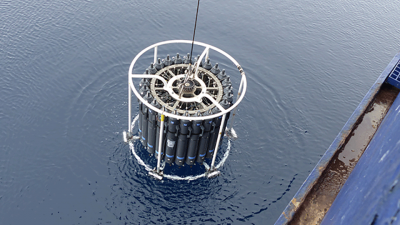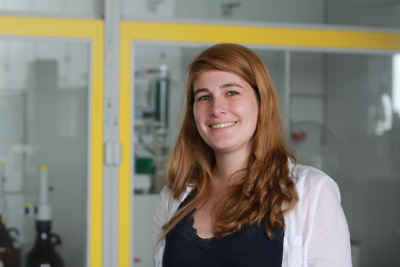Page path:
- Home
- Discover
- Media Releases
- Media Releases 2016
- 01-11-2016 Mealtime for microbes: organic sulfu...
Mealtime for microbes: organic sulfur in the ocean
Oct 31, 2016

Water samples were collected in the sampling bottles of a CTD rosette (Conductivity, Temperature, Depth) on board the research ice-breaker Polarstern. The CTD sensors measure important environmental parameters from the water surface to the sea floor. Photo: MARUM, Center for Marine Environmental Sciences, University of Bremen; K. Ksionzek
Carbon, nitrogen, phosphorus and sulfur are essential elements of life in the ocean. If one of them is missing, organisms cannot survive. Although the carbon, nitrogen and phosphorus cycles in the ocean are well understood, until now, researchers know little about the amounts of sulfur and its processes of decomposition. This also includes the impact of sulfur on climate change when it is released from chemical compounds. Researchers working in collaboration with Kerstin Ksionzek and Prof. Dr. Boris Koch have been addressing questions on the role of sulfur. They have now published their results in the journal Science.
The primary focus of the collaborative work, which included researchers from MARUM, the Center for Marine Environmental Sciences at the University of Bremen and the Alfred Wegener Institute Helmholtz Centre for Polar and Marine Research (AWI) in Bremerhaven, was the role of dissolved organic sulfur compounds and their impact on climate change. “What we know about the importance of organic sulfur in the ocean is that it is a basic building block in the composition of proteins, that large amounts of sulfur are produced from sulfates by single-celled algae, and that bacteria in the ocean require sulfur as an energy source,” says Prof. Dr. Boris Koch.
Beyond a doubt, there are sulfur compounds in the ocean that play a role in climate processes. “Dimethylsulfoniumpropionate, DMSP, for example, is a sulfur compound that is produced by algae and from which dimethylsulfide (DMS) is formed. DMS is a gas that is responsible for the odor of the sea and that is involved in cloud-formation processes,” explains Kerstin Ksionzek. “We realized that there are large gaps in our understanding of the sulfur cycle in the ocean.” In former studies researchers have focused on climate-relevant gaseous compounds. “It has now become clear that these components account for less than three percent of the sulfur annually bound by algae. We now know that there are at least 6.7 billion metric tons of dissolved organic sulfur in the ocean which originates from the remains of marine organisms, and about whose role we need to learn more,” adds Boris Koch. Another discovery of the study is that the sulfur compounds are preferentially used by bacteria as an energy source, thus organic sulfur compounds are degraded faster than organic carbon compounds without sulfur.
Crucial questions for the study were, what happens to the sulfur compounds when the algae cells die, and what is the actual amount of organic sulfur in the ocean. How much remains and how fast is it degraded? Are climate-relevant gases released during degradation processes?
The study is based on samples from the East Atlantic Ocean which were taken during an expedition from Bremerhaven via Cape Town to Antarctica on the research ice breaker Polarstern. Back in the laboratories, mass spectrometry analyses provided evidence on the age, amount and composition of the sulfur compounds.
“We worked with the remains of life in the ocean because, figuratively speaking, one must also study the soil in order to understand the biochemical processes on land,” says Kerstin Ksionzek.
The authors believe that these findings will have an impact on the work of scientists in marine biochemistry, biology and microbiology, and may be applied to future climate models.
Original publication:
Kerstin B. Ksionzek, Oliver J. Lechtenfeld, S. Leigh McCallister, Philippe Schmitt-Kopplin, Jana K. Geuer, Walter Geibert, Boris P. Koch
Dissolved organic sulfur in the ocean: Biogeochemistry of a petagram inventory.
Science 2016, DOI: 10.1126/science.aaf7796
Contact:
Kerstin B. Ksionzek
Ecological Chemistry
Telephone: +49 471 4831 1624
Email: [Bitte aktivieren Sie Javascript]
Further information / photo material:
Ulrike Prange
MARUM Public Relations
Telephone: +49 421 218 65540
Email: [Bitte aktivieren Sie Javascript]
The primary focus of the collaborative work, which included researchers from MARUM, the Center for Marine Environmental Sciences at the University of Bremen and the Alfred Wegener Institute Helmholtz Centre for Polar and Marine Research (AWI) in Bremerhaven, was the role of dissolved organic sulfur compounds and their impact on climate change. “What we know about the importance of organic sulfur in the ocean is that it is a basic building block in the composition of proteins, that large amounts of sulfur are produced from sulfates by single-celled algae, and that bacteria in the ocean require sulfur as an energy source,” says Prof. Dr. Boris Koch.
Beyond a doubt, there are sulfur compounds in the ocean that play a role in climate processes. “Dimethylsulfoniumpropionate, DMSP, for example, is a sulfur compound that is produced by algae and from which dimethylsulfide (DMS) is formed. DMS is a gas that is responsible for the odor of the sea and that is involved in cloud-formation processes,” explains Kerstin Ksionzek. “We realized that there are large gaps in our understanding of the sulfur cycle in the ocean.” In former studies researchers have focused on climate-relevant gaseous compounds. “It has now become clear that these components account for less than three percent of the sulfur annually bound by algae. We now know that there are at least 6.7 billion metric tons of dissolved organic sulfur in the ocean which originates from the remains of marine organisms, and about whose role we need to learn more,” adds Boris Koch. Another discovery of the study is that the sulfur compounds are preferentially used by bacteria as an energy source, thus organic sulfur compounds are degraded faster than organic carbon compounds without sulfur.
Crucial questions for the study were, what happens to the sulfur compounds when the algae cells die, and what is the actual amount of organic sulfur in the ocean. How much remains and how fast is it degraded? Are climate-relevant gases released during degradation processes?
The study is based on samples from the East Atlantic Ocean which were taken during an expedition from Bremerhaven via Cape Town to Antarctica on the research ice breaker Polarstern. Back in the laboratories, mass spectrometry analyses provided evidence on the age, amount and composition of the sulfur compounds.
“We worked with the remains of life in the ocean because, figuratively speaking, one must also study the soil in order to understand the biochemical processes on land,” says Kerstin Ksionzek.
The authors believe that these findings will have an impact on the work of scientists in marine biochemistry, biology and microbiology, and may be applied to future climate models.
Original publication:
Kerstin B. Ksionzek, Oliver J. Lechtenfeld, S. Leigh McCallister, Philippe Schmitt-Kopplin, Jana K. Geuer, Walter Geibert, Boris P. Koch
Dissolved organic sulfur in the ocean: Biogeochemistry of a petagram inventory.
Science 2016, DOI: 10.1126/science.aaf7796
Contact:
Kerstin B. Ksionzek
Ecological Chemistry
Telephone: +49 471 4831 1624
Email: [Bitte aktivieren Sie Javascript]
Further information / photo material:
Ulrike Prange
MARUM Public Relations
Telephone: +49 421 218 65540
Email: [Bitte aktivieren Sie Javascript]



